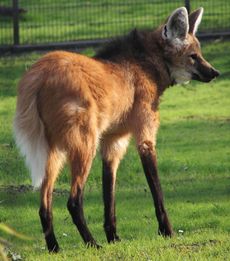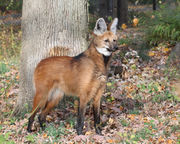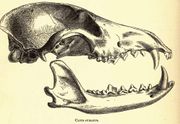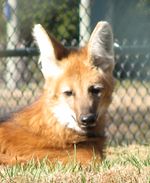Maned Wolf
| Maned Wolf [1] | |
|---|---|
 |
|
| Conservation status | |
| Scientific classification | |
| Kingdom: | Animalia |
| Phylum: | Chordata |
| Class: | Mammalia |
| Order: | Carnivora |
| Family: | Canidae |
| Subfamily: | Caninae |
| Genus: | Chrysocyon C. E. H. Smith, 1839 |
| Species: | C. brachyurus |
| Binomial name | |
| Chrysocyon brachyurus (Illiger, 1815) |
|
 |
|
| Maned Wolf range | |
The Maned Wolf (Chrysocyon brachyurus) is the largest canid of South America, resembling a large fox with reddish fur.
This mammal is found in open and semi-open habitats, especially grasslands with scattered bushes and trees, in south, central-west and south-eastern Brazil (Mato Grosso, Mato Grosso do Sul, Minas Gerais, Goiás, São Paulo, Federal District and recently Rio Grande do Sul), Paraguay, northern Argentina, Bolivia east and north of the Andes,[3] and far south-eastern Peru (Pampas del Heath only).[4] It is very rare in Uruguay. IUCN lists it as near threatened,[2] while it is considered vulnerable by the Brazilian government (IBAMA). It is the only species in the genus Chrysocyon. It is locally known as aguará guazú (meaning “large fox”) in the Guarani language, as "lobo guará" in Portuguese and as "lobo de crin" in Spanish.
Contents |
Description


The Maned Wolf has often been described as "a Red Fox on stilts" owing to its similar coloration and overall appearance, though it is much larger than a Red Fox and belongs to a different genus. The adult animal stands almost 1 m (3.3 ft) tall at the shoulder, and weighs 20 to 25 kg (44 to 55 lb).[5] The maned wolf is the tallest of the wild canids. The long legs are probably an adaptation to the tall grasslands of its native habitat.[6] Fur of the Maned Wolf may be reddish brown to golden orange on the sides with long, black legs and a distinctive black mane. The coat is further marked with a whitish tuft at the tip of the tail and a white "bib" beneath the throat. The mane is erectile, and is typically used to enlarge the wolf's profile when threatened or when displaying aggression.
The maned wolf is also known for its distinctive odor, which has earned it the nickname "Skunk Wolf."
Habits
Hunting and territoriality
Unlike other large canids (such as the Gray Wolf, the African Hunting Dog, or the Dhole) the Maned Wolf does not form packs.[5] It hunts alone, usually between sundown and midnight. It kills its prey by biting on the neck or back, and shaking it violently if necessary.[7] Monogamous pairs may defend a shared territory of about 30 km2 (11.6 sq mi), though the wolves themselves may seldom meet, outside of mating. The territory is crisscrossed by paths that the wolves create as they patrol at night. Several adults may congregate in the presence of a plentiful food source; a fire-cleared patch of grassland, for example, which would leave small vertebrate prey exposed to foraging.
Both male and female Maned Wolves use their urine to communicate, e.g. to mark their hunting paths, or the places where they have buried hunted prey.[7] The urine has a very distinctive smell, which some people liken to hops or cannabis. The responsible substance is very likely a pyrazine, which occurs in both plants. (In the Rotterdam Zoo, this smell once set the police on a hunt for cannabis smokers.[8])

Reproduction
The mating season ranges from November to February. Gestation lasts 60 to 65 days, and a litter may have up to 2 to 6 black-furred pups, each weighing about 450 g (16 oz). These pups are fully grown in about one year.[7]
Diet
The Maned Wolf specializes in small and medium-sized prey, including small mammals (typically rodents and hares), birds, and even fish.[9][7] A large fraction of its diet (over 50%, according to some studies) is vegetable matter, including sugarcane, tubers, and fruit (especially the Wolf Apple (Solanum lycocarpum).[10] Captive Maned Wolves were traditionally fed meat-heavy diets and developed bladder stones. Zoo diets now feature fruits and vegetables, as well as meat and dog chow.
Relations with other species
The Maned Wolf participates in symbiotic relationships with the plants that it feeds on, as it carries the seeds of various plants, and often defecates on the nests of leafcutter ants. The ants then use the dung to fertilize their fungus gardens, and later discard the seeds onto refuse piles just outside their nest. This process significantly increases the germination rate of the seeds.[11] The wolf is particularly susceptible to infection by the giant kidney worm, a potentially fatal parasite that may also infect domestic dogs. The Maned Wolf is not a common prey species for any other predator, though it may be attacked or killed by feral domestic dogs.
Relations with humans
The Maned Wolf is said to be a potential chicken thief; it was once also considered a threat to cattle and sheep, though this is now known to be false. In Brazil, the animal was historically hunted down for some body parts, notably the eyes, that were believed to be good luck charms. However, as it is now classified as vulnerable by the Brazilian government, it is afforded protection from poachers. Wolves are also threatened by habitat loss and being run over by cars. Wolves risk both physical harm and catching diseases from domestic dogs. The Maned Wolf is generally shy and flees when alarmed, and it poses little direct threat to humans. It occurs in several protected areas, including the national parks of Caraça and Emas in Brazil. The Maned Wolf is well represented in captivity, and has been bred successfully at a number of zoos, particularly in Argentina.
Taxonomy
The Maned Wolf is not closely related to any other living canid. It is apparently a survivor from the Pleistocene fauna of large South American mammals; its closest living relative is the Bush Dog (genus Speothos), with a more distant relationship to other South American canines (the Short-eared Dog, the Crab-eating Fox and the 'false foxes' or Pseudalopex).[12]
A study published in 2009 based on DNA evidence, showed that the extinct Falkland Islands Wolf was most closely related to the Maned Wolf, and shared a common ancestor with it about 6 million years ago.[13] An earlier study,[14] published in 2003, on the brain anatomy of several canids placed the Maned Wolf indeed together with the Falkland Islands Wolf, though with pseudo-foxes of the genus Pseudalopex as well.
Gallery
|
|
 |
 |
|
References
- ↑ Wozencraft, W. Christopher (16 November 2005). "Order Carnivora (pp. 532-628)". In Wilson, Don E., and Reeder, DeeAnn M., eds. Mammal Species of the World: A Taxonomic and Geographic Reference (3rd ed.). Baltimore: Johns Hopkins University Press, 2 vols. (2142 pp.). ISBN 978-0-8018-8221-0. OCLC 62265494. http://www.bucknell.edu/msw3/browse.asp?id=14000790.
- ↑ 2.0 2.1 Rodden, M., Rodrigues , F. & Bestelmeyer, S. (2008). Chrysocyon brachyurus. In: IUCN 2008. IUCN Red List of Threatened Species. Downloaded on 22 March 2009. Database entry includes justification for why this species is near threatened.
- ↑ Langguth, A. (1975). "Ecology and evolution in the South American canids". In M. W. Fox, ed.. The wild canids: their systematics, behavioral ecology and evolution. New York: Van Nostrand Reinhold Company. pp. 192–206.
- ↑ Sillero-Zubiri, Hoffmann, & Macdonald (eds). 2004.Canids: Foxes, Wolves, Jackals and Dogs - 2004 Status Survey and Conservation Action Plan. IUCN/SSC Canid Specialist Group.
- ↑ 5.0 5.1 Dietz, J. M. (1984). "Ecology and social organization of the maned wolf (Chrysocyon brachyurus)". Smithsonian Contributions to Zoology 392: 1–51.
- ↑ Dietz, James (1984). Macdonald, D.. ed. The Encyclopedia of Mammals. New York: Facts on File. pp. 31. ISBN 0-87196-871-1.
- ↑ 7.0 7.1 7.2 7.3 Cristian Frers. "Un lobo de crin llamado Aguará Guazú". http://www.internatura.org/estudios/informes/lobo.html. Retrieved 2007-04-23.
- ↑ Süddeutsche Zeitung, 2006-09-02, p3
- ↑ Juarez, Keila Macfadem; Jader Marinho-Filho (November 2002). "Diet, habitat use, and home ranges of sympatric canids in central Brazil". Journal of Mammalogy 83 (4): 925–934. doi:10.1644/1545-1542(2002)083<0925:DHUAHR>2.0.CO;2.
- ↑ Motta-Junior, J. C., S. A. Talamon, J. A. Lombardi, AND K. Simokomaki (1996). "Diet of maned wolf, Chrysocyon brachyurus, in central Brazil". Journal of Zoology (London) 240: 277–284. doi:10.1111/j.1469-7998.1996.tb05284.x.
- ↑ O. Courtenay. "Conservation of the Maned Wolf: fruitful relationships in a changing environment". Canid News, Vol. 2, 1994. http://www.canids.org/PUBLICAT/CNDNEWS2/manedwf2.htm.
- ↑ Kerstin, Lindblad-Toh; Claire M Wade, Tarjei S. Mikkelsen, Elinor K. Karlsson, David B. Jaffe, Michael Kamal, Michele Clamp, Jean L. Chang, Edward J. Kulbokas III, Michael C. Zody, Evan Mauceli, Xiaohui Xie, Matthew Breen, Robert K. Wayne, Elaine A. Ostrander, Chris P. Ponting, Francis Galibert, Douglas R. Smith, Pieter J. deJong, Ewen Kirkness, Pablo Alvarez, Tara Biagi, William Brockman, Jonathan Butler, Chee-Wye Chin, April Cook, James Cuff, Mark J. Daly, David DeCaprio, Sante Gnerre, Manfred Grabherr, Manolis Kellis, Michael Kleber, Carolyne Bardeleben, Leo Goodstadt, Andreas Heger, Christophe Hitte, Lisa Kim, Klaus-Peter Koepfli, Heidi G. Parker, John P. Pollinger, Stephen M. J. Searle, Nathan B. Sutter, Rachael Thomas, Caleb Webber (2005-12-08). "Genome sequence, comparative analysis and haplotype structure of the domestic dog". Nature 438 (7069): 803–819. doi:10.1038/nature04338. PMID 16341006.
- ↑ http://www.sciencedaily.com/releases/2009/11/091102121449.htm
- ↑ Lyras, G.A., Van der Geer, A.A.E. 2003. External brain anatomy of the Canidae. Zoological Journal of the Linnean Society 138: 505-522. London. doi: 10.1046/j.1096-3642.2003.00067.x
External links
- ARKive - images and movies of the maned wolf (Chrysocyon brachyurus).
- Consorte-McCrea, Adriana G. The Maned Wolf in Captivity. Canid News, Vol. 2, 1994. Accessed March 12, 2007.
- Gorog, Antonia. Chrysocyon brachyurus (maned wolf). Animal Diversity Web. Accessed March 12, 2007.
- Emmons, Louise- [1] The Secret Wolf
|
|||||||||||||||||||||||||||||||||||||||||||||||||||||||||||||||||||||||||||||||||||||||||||||||||||||||||||||||||||||||||||||||||||||||||||||||||||||||||||||||||||||||||||||||||||||||||||||||||||||||||||||||||||||||||||||||||||||||||||||||||||||||||||||||||||||||||||||||||||||||||||||||||||||||||||||||||||||||||||||||||||||||||||||||||||||||||||||||||||||||||||||||||||||||||||||||||||||||||||||||||||||||||||||||||||||||||||||||||||||||||||||||||||||||||||||||||||||||||||||||||||||||||||